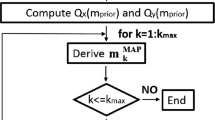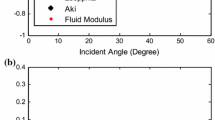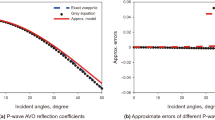Abstract
Petrophysical seismic inversion, aided by rock physics, aims at estimating reservoir properties based on reflection events, but it is generally based on the Gassmann equation, which precludes its applicability to complex reservoirs. To overcome this problem, we present a methodology based on the double-porosity Biot–Rayleigh (BR) model, which takes into account the rock heterogeneities. The volume ratio of inclusions in the BR model is treated as a spatially varying parameter, facilitating a better description of the pore microstructure. The method includes the Zoeppritz equations to extract reservoir properties from prestack data. To handle the ill-posedness of the inversion and achieve a stable solution, the algorithm is formulated as a multi-objective optimization based on the Bayes theorem, where the reservoir-property estimation is jointly conditioned to seismic and elastic data with multiple prior terms. The method is validated with field data of a tight gas sandstone reservoir, illustrating its effectiveness compared to the Gassmann-based estimation, reducing uncertainties and improving the accuracy of identifying gas zones.
Article Highlights
-
The petrophysical seismic inversion is based on the double-porosity Biot–Rayleigh model
-
Spatially varying inclusion volumes are used to describe complex pore structures
-
A multi-objective optimization with joint data misfit enables stable results
















Similar content being viewed by others
References
Aki K, Richards PG (1980) Quantitative seismology. W H Freeman & Co
Aleardi M, Ciabarri F, Calabrò R (2018) Two-stage and single-stage seismic-petrophysical inversions applied in the Nile Delta. Lead Edge 37(7):510–518
Astic T, Heagy LJ, Oldenburg DW (2021) Petrophysically and geologically guided multi-physics inversion using a dynamic Gaussian mixture model. Geophys J Int 224(1):40–68
Avseth P, Bachrach R (2005) Seismic properties of unconsolidated sands: tangential stiffness, Vp/Vs ratios and diagenesis. In: SEG Technical Program Expanded Abstracts, pp 1473–1476
Avseth P, Veggeland T (2014) Seismic screening of rock stiffness and fluid softening using rock-physics attributes. Interpretation 3(4):SAE85–SAE93
Azevedo L, Grana D, Amaro C (2019) Geostatistical rock physics AVA inversion. Geophys J Int 216(3):1728–1739
Bachrach R (2006) Joint estimation of porosity and saturation using stochastic rock-physics modeling. Geophysics 71(5):O53–O63
Ba J, Carcione JM, Nie J (2011) Biot-Rayleigh theory of wave propagation in double-porosity media. J Geophys Res 116:B06202
Ba J, Xu W, Fu L-Y, Carcione JM, Zhang L (2017) Rock anelasticity due to patchy-saturation and fabric heterogeneity: a double double-porosity model of wave propagation. J Geophys Res 122:1949–1971
Berryman JG, Pride SR, Wang HF (2002) A differential scheme for elastic properties of rocks with dry or saturated cracks. Geophys J Int 151:597–611
Bosch M, Cara L, Rodrigues J, Navarro A, Díaz M (2007) A Monte Carlo approach to the joint estimation of reservoir and elastic parameters from seismic amplitudes. Geophysics 72(6):O29–O39
Bosch M, Mukerji T, Gonzalez EF (2010) Seismic inversion for reservoir properties combining statistical rock physics and geostatistics: a review. Geophysics 75(5):75A165-75A176
Bredesen K, Rasmussen R, Mathiesen A, Nielsen LH (2021) Seismic amplitude analysis and rock physics modeling of a geothermal sandstone reservoir in the southern part of the Danish Basin. Geothermics 89:101974
Buland A, Omre H (2003) Bayesian linearized AVO inversion. Geophysics 68(1):185–198
Carcione JM, Gurevich B, Santos JE, Picotti S (2013) Angular and frequency dependent wave velocity and attenuation in fractured porous media. Pure Appl Geophys 170:1673–1683
Carcione JM (2014) Wavefields in real media: Theory and numerical simulation of wave propagation in anisotropic, anelastic, porous and electromagnetic media, 3rd edn. Elsevier
Chen H, Moradi S, Innanen KA (2021) Joint inversion of frequency components of PP- and PSV-wave amplitudes for attenuation factors using second-order derivatives of anelastic impedance. Surv Geophys 42:961–987
Connolly PA, Hughes MJ (2016) Stochastic inversion by matching to large numbers of pseudo-wells. Geophysics 81(2):M7–M22
David EC, Zimmerman RW (2012) Pore structure model for elastic wave velocities in fluid-saturated sandstones. J Geophys Res 117:B07210
de Figueiredo LP, Grana D, Roisenberg M, Rodrigues BB (2019) Multimodal Markov chain Monte Carlo method for nonlinear petrophysical seismic inversion. Geophysics 84(5):M1–M13
Dvorkin J, Gutierrez M, Grana D (2014) Seismic reflections of rock properties. Cambridge University Press
Dvorkin J, Nur A (1993) Dynamic poroelasticity: a unified model with the squirt and the Biot mechanisms. Geophysics 58(4):524–533
Fjeldstad T, Avseth P, Omre H (2021) A one-step Bayesian inversion framework for 3D reservoir characterization based on a Gaussian mixture model: a Norwegian Sea demonstration. Geophysics 86(2):R221–R236
Gassmann F (1951) Elastic waves through a packing of spheres. Geophysics 16(4):673–685
González EF, Mukerji T, Markov G (2008) Seismic inversion combining rock physics and multiple-point geostatistics. Geophysics 73(1):R11–R21
Grana D, Fjeldstad T, Omre H (2017) Bayesian Gaussian mixture linear inversion for geophysical inverse problems. Math Geosci 49:493–515
Grana D (2020) Bayesian petroelastic inversion with multiple prior models. Geophysics 85(5):M57–M71
Gunning J, Glinsky M (2007) Detection of reservoir quality using Bayesian seismic inversion. Geophysics 72(3):R37–R49
Gurevich B, Brajanovski M, Galvin RJ, Muller TM, Toms-Stewart J (2009) P-wave dispersion and attenuation in fractured and porous reservoirs: poroelasticity approach. Geophys Prospect 57(2):225–237
Guo Q, Ba J, Fu L-Y, Luo C (2021a) Joint seismic and petrophysical nonlinear inversion with Gaussian mixture-based adaptive regularization. Geophysics 86(6):R895–R911
Guo Q, Ba J, Luo C, Pang M (2021b) Seismic rock physics inversion with varying pore aspect ratio in tight sandstone reservoirs. J Petrol Sci Eng 207:109131
Hafez A, Majoor F, Castagna JP (2014) Deepwater reservoir heterogeneity delineation using rock physics and extended elastic impedance inversion: Nile Delta case study. Interpretation 2(4):T205–T219
Hammer H, Kolbjørnsen O, Tjelmeland H, Buland A (2012) lithofacies and fluid prediction from prestack seismic data using a Bayesian model with Markov process prior. Geophys Prospect 60(3):500–515
Hansen TM, Journel AG, Tarantola A, Mosegaard K (2006) Linear inverse Gaussian theory and geo-statistics. Geophysics 71(6):R101–R111
Huang G, Chen X, Luo C, Chen Y (2021a) Mesoscopic wave-induced fluid flow effect extraction by using frequency-dependent prestack waveform inversion. IEEE Trans Geosci Remote Sens 59(8):6510–6524
Huang G, Chen X, Li J, Saad OM, Fomel S, Luo C, Wang H, Cheng Y (2021b) The slope-attribute-regularized high-resolution prestack seismic inversion. Surv Geophys 42:625–671
Ingber L, Rosen B (1992) Genetic algorithms and very fast simulated reannealing: a comparison. Math Comput Model 16:87–100
Jalobeanu A, Blanc-Feraud L, Zerubia J (2002) Hyperparameter estimation for satellite image restoration using a MCMC maximum likelihood method. Pattern Recogn 35(2):341–352
Li K, Yin X, Zong Z, Lin H (2021) Direct estimation of discrete fluid facies and fluid indicators via a Bayesian seismic probabilistic inversion and a novel exact PP-wave reflection coefficient. J Petrol Sci Eng 196:107412
Luo C, Ba J, Carcione J, Huang G, Guo Q (2020) Joint PP and PS pre-stack seismic inversion for stratified models based on the propagator matrix forward engine. Surv Geophys 41:987–1028
Markov M, Levine V, Mousatov A, Kazatchenko E (2005) Elastic properties of double-porosity rocks using the differential effective medium model. Geophys Prospect 53(5):733–754
Mavko G, Mukerji T, Dvorkin J (2009) The rock physics handbook: tools for seismic analysis of porous media. Cambridge University Press
Mosegaard K (1998) Resolution analysis of general inverse problems through inverse Monte Carlo sampling. Inverse Prob 14:405–426
Norris AN (1985) A differential scheme for the effective moduli of composites. Mech Mater 4(1):1–16
Pan X, Zhang G (2018) Model parameterization and PP-wave amplitude versus angle and azimuth (AVAZ) direct inversion for fracture quasi-weaknesses in weakly anisotropic elastic media. Surv Geophys 39:937–964
Pang M, Ba J, Fu L-Y, Carcione JM, Markus UI, Zhang L (2020) Estimation of microfracture porosity in deep carbonate reservoirs based on 3D rock-physics templates. Interpretation 8(4):43–52
Pang M, Ba J, Carcione JM (2021) Characterization of gas saturation in tight-sandstone reservoirs with rock-physics templates based on seismic Q. J Energ Eng 147(3):04021011
Pride SR, Berryman JG, Harris JM (2004) Seismic attenuation due to wave-induced flow. J Geophys Res 109:B01201
Picotti S, Carcione JM, Ba J (2018) Rock-physics templates for seismic Q. Geophysics 84(1):MR13–MR23
Ryden N, Park CB (2006) Fast simulated annealing inversion of surface waves on pavement using phase-velocity spectra. Geophysics 71(4):R49–R58
Sambridge M, Mosegaard K (2002) Monte Carlo methods in geophysical inverse problems. Rev Geophys 40(3):1–29
Santos JE, Ravazzoli CL, Carcione JM (2004) A model for wave propagation in a composite solid matrix saturated by a single-phase fluid. J Acoust Soc Am 115:2749–2760
Sauvageau M, Gloaguen E, Claprood M, Lefebvre R, Bêche M (2014) Multimodal reservoir porosity simulation: an application to a tight oil reservoir. J Appl Geophys 107:71–79
Sen MK, Stoffa PL (2013) Global optimization methods in geophysical inversion. Cambridge University Press
Spikes K, Mukerji T, Dvorkin J, Mavko G (2007) Probabilistic seismic inversion based on rock- physics models. Geophysics 72(5):R87–R97
Teillet T, Fournier F, Zhao L, Borgomano J, Hong F (2021) Geophysical pore type inversion in carbonate reservoir: integration of cores, well logs, and seismic data (Yadana field, offshore Myanmar). Geophysics 86(3):B149–B164
Wang E, Carcione JM, Ba J, Liu Y (2020) Reflection and transmission of plane elastic waves at an interface between two double-porosity media: effect of local fluid flow. Surv Geophys 41:283–322
Wang H, Tang X (2021) Inversion of dry and saturated P- and S-wave velocities for the pore-aspect-ratio spectrum using a cracked porous medium elastic wave theory. Geophysics 86(6):A57–A62
Wang P, Chen X, Li X, Cui Y, Li J, Wang B (2021) Analysis and estimation of an inclusion-based effective fluid modulus for tight gas-bearing sandstone reservoirs. IEEE Trans Geosci Remote Sens (online). https://doi.org/10.1109/TGRS.2021.3099134
Xu S, White RE (1995) A new velocity model for clay-sand mixtures. Geophys Prospect 43:91–118
Yan J, Li X, Liu E (2002) Effects of pore aspect ratios on velocity prediction from well-log data. Geophys Prospect 50(3):289–300
Zhao L, Nasser M, Han DH (2013) Quantitative geophysical pore type characterization and its geological implication in carbonate reservoirs. Geophys Prospect 61(4):827–841
Zong Z, Yin X, Wu G (2015) Geofluid discrimination incorporating poroelasticity and seismic reflection inversion. Surv Geophys 36:659–681
Zidan A, Li YE, Cheng A (2021) A Pareto multi-objective optimization approach for anisotropic shale models. J Geophys Res 126:e2020JB021476
Acknowledgements
We appreciate the editor and two anonymous reviewers for their valuable comments. This work is supported by the National Nature Science Foundation of China (41974123, 42104128), the Jiangsu Province Science Fund for Distinguished Young Scholars (BK20200021), and the Natural Science Foundation of Zhejiang Province (LQ21D040001).
Author information
Authors and Affiliations
Corresponding author
Additional information
Publisher's Note
Springer Nature remains neutral with regard to jurisdictional claims in published maps and institutional affiliations.
Appendices
Appendix A: The Biot–Rayleigh equation and its plane-wave solution
Ba et al. (2011) proposed the Biot–Rayleigh model to describe the seismic wave propagation in a double-porosity medium. The governing equations are
where u, U(1), and U(2) are the average particle displacements of the skeleton, and the average fluid displacements in the host and inclusion, respectively, with volume strains ε, ζ(1), and ζ(2), ϕ10 and ϕ20 are the porosities of the host and inclusion with their absolute porosities ϕ1 and ϕ2, κ1 and η are the host-medium permeability and fluid viscosity, respectively, ς denotes the fluid strain increment in the local fluid flow and Ro is the radius of inclusion. The equations contain six stiffness parameters A, N, Q1, Q2, R1, R2, five density coefficients ρ11, ρ12, ρ13, ρ22, ρ33, and two Biot dissipation coefficients b1 and b2.
By substituting a plane-wave kernel into Eqs. (19)–(20), the complex wave number k can be obtained from
where
and
Equation (23) yields three roots, and we choose the fast P-wave one (the classical compressional wave). The phase velocity is given by Carcione (2014) as
where ω is the angular frequency.
Appendix B: Update of posterior weights
Jalobeanu et al. (2002) and Guo et al. (2021a) proposed to update the regularization parameters by using the Monte-Carlo-based maximum likelihood method. We hereby extend the method to be applicable to the multi-objective optimization problem with joint data misfits.
The likelihood function of Eq. (15) is
where the Ω denotes the data space of z. Given the known β, we have
where F1 and F2 denote the seismic and elastic misfit terms in Eq. (12), and
are the normalization constants.
The prior distribution of P(z|β) is
where F3 denotes the prior term in Eq. (12), and
is a normalization constant.
By substituting Eqs. (28) and (30) into (27), the likelihood function of β can be expressed as the negative logarithm of P(dseis,delas|β)
with
By employing the Gauss–Newton descent method to minimize the log-likelihood function 32, β can be iteratively updated as
with
Introducing the expectation of z, regarding its probability distribution, Eq. (35) can be estimated from the expectations of one prior distribution (Eβ) and two posterior distributions (Ez and Ee) as
By setting the quadratic form of \({{\varvec{\upbeta}}} = \left[ {\beta_{1}^{2} ,\beta_{2}^{2} } \right]^{{\text{ T}}}\) to compute the derivative and to ensure its value positive, the derivative in Eq. (32) [or Eq. (16)] can be estimated as
where F2* and F3*denote the F2 and F3 terms without β1 and β2.
Rights and permissions
About this article
Cite this article
Guo, Q., Ba, J. & Carcione, J.M. Multi-Objective Petrophysical Seismic Inversion Based on the Double-Porosity Biot–Rayleigh Model. Surv Geophys 43, 1117–1141 (2022). https://doi.org/10.1007/s10712-022-09692-6
Received:
Accepted:
Published:
Issue Date:
DOI: https://doi.org/10.1007/s10712-022-09692-6




